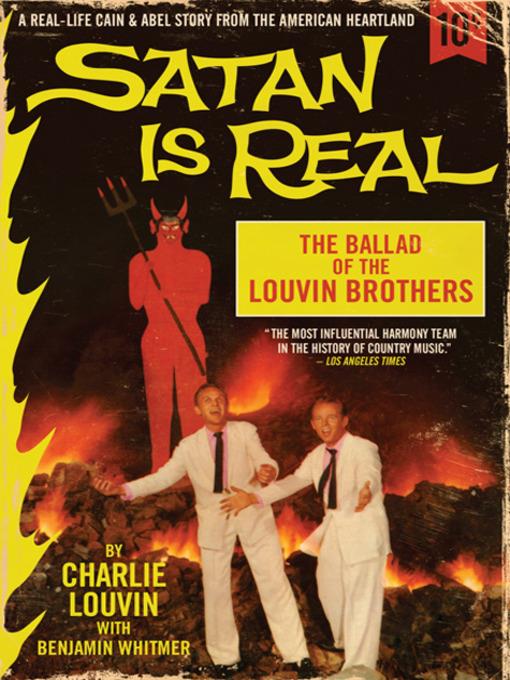
Satan Is Real
The Ballad of the Louvin Brothers
کتاب های مرتبط
- اطلاعات
- نقد و بررسی
- دیدگاه کاربران
نقد و بررسی

November 21, 2011
Kris Kristofferston, who was employed as a janitor when he met Charlie Louvin, writes in his foreword, “The legendary Louvin Brothers’ hauntingly beautiful Appalachian blood-brothers harmony is truly one of the treasures of American music.” Now Charlie Louvin, who died January 26, 2011, at age 83, has written an engaging and entertaining look back at his gospel and country music career with his brother, Ira. The two grew up picking cotton and coon hunting in Alabama, and music became their escape route from rural chores to radio fame. They were in their teens when they began singing on Chattanooga radio, a showcase that led to paying gigs. They moved on to making music in Memphis, and by 1955, when they finally got to the Grand Ole Opry, their record sales soared. Ira’s heavy drinking and temper tantrums prompted Charlie to go solo; tragedy struck when Ira was killed in a 1965 auto accident. Packed with plenty of pictures, backstage gossip, and colorful anecdotes about the Louvins’ encounters with the great and near great, this memoir has a raw honesty, genuine grit, common sense and smokin’ down-home flavor that Louvin fans will relish. The fire-and-brimstone cover art and the book’s title are both taken from the duo’s 1959 gospel album, Satan Is Real.

January 1, 2012
The Louvin Brothers were the preeminent country harmony duo of the post-World War II era. With a repertoire of classic folk songs such as "Mary of the Moors" and originals like "When I Stop Dreaming," they realized their dream of becoming Grand Ole Opry mainstays and influences on generations of musicians. This book, titled after one of their most celebrated albums, tells their story from the viewpoint of the recently deceased Charlie Louvin, the younger brother who survived to carry their legacy into the 21st century. Ira, the more ambitious and mercurial brother, is portrayed as magnificently self-destructive via alcoholism, multiple ill-advised marriages, and fits of temper that would manifest in frequent onstage smashings of his out-of-tune mandolin. In the most effective passages in this volume, Charlie describes his rural Alabama childhood with an abusive father and a mother who teaches the boys their core repertoire. VERDICT An important part of American roots music history, told in an authentic voice. Recommended for any serious popular music collection.--John Frank, Los Angeles P.L.
Copyright 2012 Library Journal, LLC Used with permission.

December 1, 2011
The tempestuous history of country music's Louvin Brothers, recalled by the younger musical sibling. Ira and Charlie Louvin were the last of the great harmony duos; in the '50s they launched a string of songs up the country charts and starred on Nashville's Grand Ole Opry. Here, Charlie (1927–2011) recounts the twosome's rise from hardscrabble beginnings in Alabama's cotton country to national fame. Basically self-taught, the brothers were reared on church singing before they launched an uphill professional career in the '40s. Louvin maps the pair's arduous journey through small-town radio gigs and endless regional touring, with flavorful, often profanely sketched observations about the hardships of making it on the road as a rising country act. Major music publisher Fred Rose took the Louvins under his wing, but after a pair of failed record deals, the brothers were ready to pack it in when they were signed to Capitol Records in the early '50s. Starting in gospel, they reached the top with secular hits like "When I Start Dreaming" and classic albums like Tragic Songs of Life. The second half of the book focuses on reckless elder brother Ira, a pugnacious, womanizing alcoholic whose violence led his third wife to shoot him six times (he survived). In the face of Ira's escalating madness, Charlie finally broke up the act in the early '60s, and Ira was killed in a 1965 road accident. Charlie never manages to put his finger on what drove his brother to such heights of destructive behavior, but he still paints a chilling portrait of a brilliant musician intent on self-annihilation. Along the way, he offers entertaining cameo renderings of such stars as Elvis Presley, Roy Acuff, Johnny Cash, Bill Monroe, George Jones and Kris Kristofferson. The self-effacing Louvin dispenses with his solo work and latter-day career revival in a couple of brief chapters. Deep analysis is not his strong suit, but his amusing, prickly voice animates the book. An engaging look at a now-distant piece of country-music history.
(COPYRIGHT (2011) KIRKUS REVIEWS/NIELSEN BUSINESS MEDIA, INC. ALL RIGHTS RESERVED.)

























دیدگاه کاربران